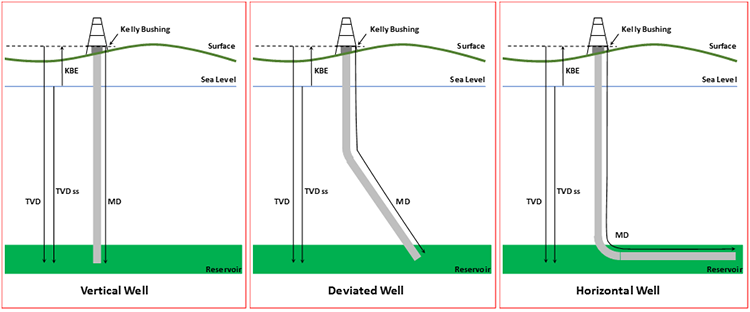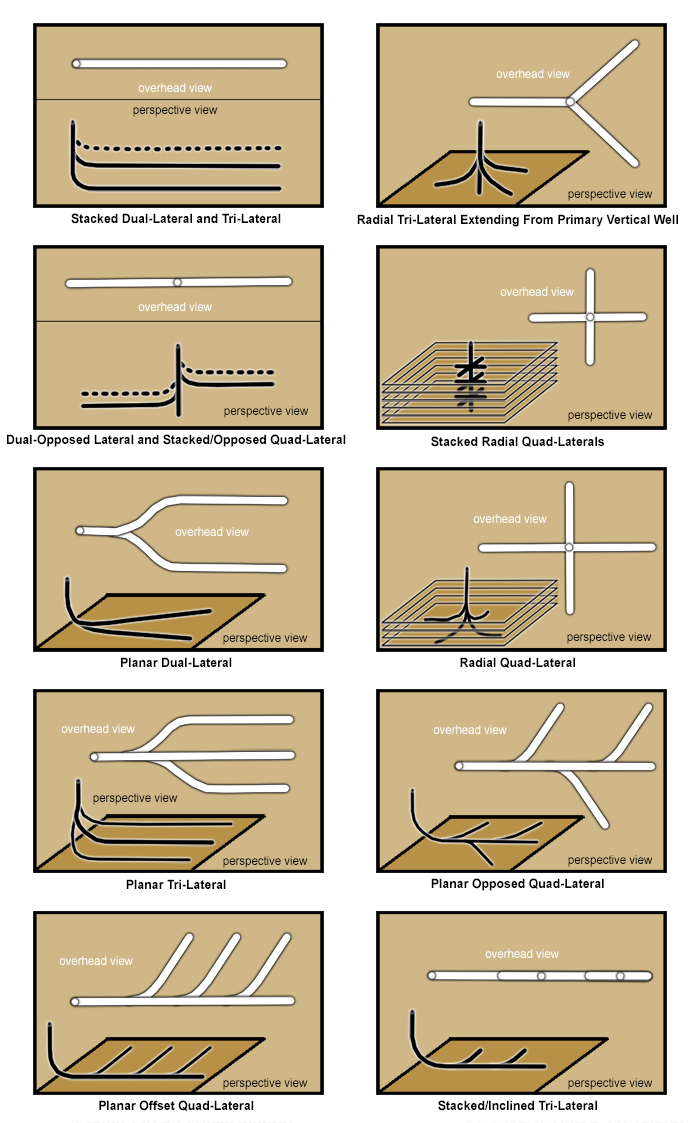We will start our discussion on well design by discussing the well orientation. In past lessons, we discussed three of the more common designs: vertical, deviated, and horizontal. These will be the well orientations that we will focus on. There are shown in Figure 7.02.

There are many other well orientations and configurations that are possible. One broad category of these more complex wells is the category of Multi-Lateral Wells. A small subset of possible multi-lateral wells is shown in Figure 7.03. Using the naming convention in Figure 7.03, a horizontal well would be called a Single-Lateral Well. The term Lateral refers to the number of horizontal branches emanating from a single vertical well section.
Historically, the most common on-shore wells have been vertical wells. This is because of their simplicity and economics. It turns out that straight vertical wells are the most economic wells that can be drilled. Rigs are contracted on a daily basis, and the fastest way to drill a well is with a vertical well (This is the shortest distance to the target because the measured depth, MD (the length that is actually drilled), is equal to the true vertical depth, TVD – see Figure 7.02.).
For offshore production wells, the most common wells tend to be deviated wells. In offshore drilling, we are normally dealing with a rig at one to three fixed drilling centers, the Production Platforms (there are other drilling centers). In these situations, the drilling rig is at a fixed position, and the vertical section of the well is drilled. The bottom-hole well target for the well is the desired location where we want to produce. In order to reach this location, we need to deviate from the vertical and drill towards the bottom-hole target. The point where we deviate from the vertical is referred to as the Kickoff Point. Deviated wells are typically more expensive than vertical wells because the measured depth is greater than the true vertical depth, so the drilled footage is greater. In addition, all casing and tubing will need to be the measured depth of the well, so costs such as casing, tubing, and cement, will be greater for a deviated well.
On-shore wells are now commonly drilled from Well Pads (temporary, compact drilling sites that are prepared specifically for drilling using local materials – for example, gravel and wood – and then removed once drilling operations are completed). Pad drilling is a relatively recent innovation and, as it turns out, deviated wells drilled from Multi-Well Pads can leave a smaller environmental footprint than vertical wells drilled from Single-Well Pads. Therefore, there is an environmental incentive for drilling deviated wells from multi-well pads. There may not be an economic incentive for multi-well pad drilling as any synergies and cost reductions captured at the surface must compensate any cost increases associated with the deviated well.

Deviated wells drilled from multi-well pads are similar to deviated wells drilled from an offshore drilling center. Wells with a common surface location are drilled to different bottom-hole targets identified by geologists and reservoir engineers.
There are many uses for deviated and horizontal (or single-lateral) wells. These include to:
- avoid well surface locations that:
- are environmentally sensitive;
- are logistically difficult (heavily forested, no suitable access roads or infrastructure, heavily populated regions, etc.);
- drill an offshore bottom-hole target from an onshore surface location;
- produce from thin formations;
- produce from low permeability formations
- produce a thin oil column in a gas or gas condensate reservoir;
- maximize the contact area of the well and reservoir;
- reduce pressure drop near the well:
- minimize production of unwanted fluids in Coning situations (I will discuss coning later in this lesson);
- minimize sand production;
- intercept natural fractures in naturally fractured reservoirs;
- assist in steam drive production of heavy oils.
If the bottom-hole target location of a well is positioned directly below a non-desirable surface location from environmental, economic, logistics, or safety perspectives, then vertical wells may not be the best option if the target location can be reached with a deviated or horizontal well. If a more desirable surface location can be found within the Drilling Radius for that bottom-hole location, then deviated or horizontal wells should be considered.
From a production perspective, horizontal wells are often more desirable for thin bottom-hole targets (reservoirs or oil columns). While vertical well lengths are limited to the reservoir thickness, that restriction does not apply to horizontal wells (see Figure 7.02). The longer the well length, the more contact area is exposed to the well. This increases the inflow performance of the well and results in higher production rates at comparable or lower drawdowns. One advantage of these lower drawdown pressures is that this helps reduce production of unwanted fluids in coning situations. I will discuss this later in this lesson.
Finally, for specialized situations, such as Naturally Fractured Reservoirs or Steam Flooding, horizontal wells also have applications.